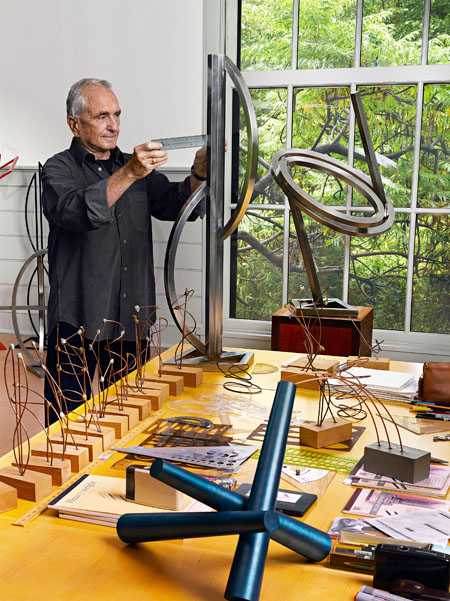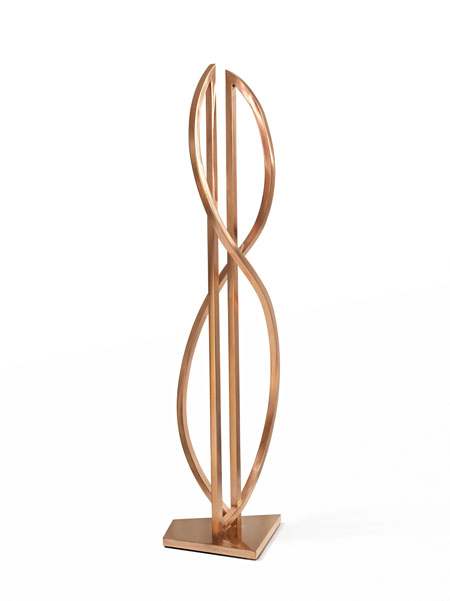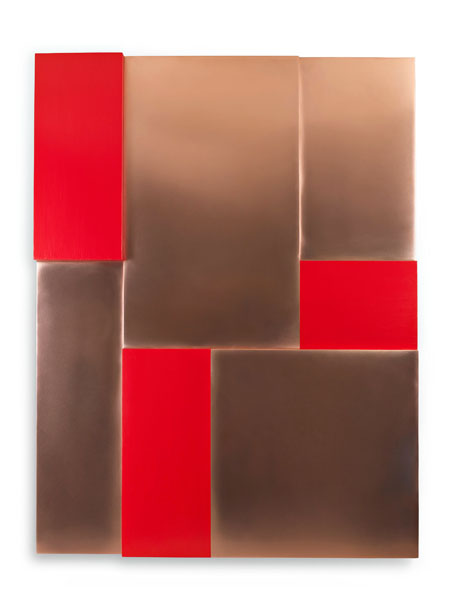Arthur Carter: Geometry and Copper Collide
Arthur Carter’s journey to becoming a sculptor began in an unlikely place — on Wall Street. Carter worked as an investment banker for 25 years and also spent time working in other trades, including newspaper publishing, before pursuing a profession in the arts in the mid 1990’s. He made a conscious decision to pursue a career as a sculptor.
“I went into the world of art, and particularly sculpture, because I knew for every 10,000 painters, there were five sculptors,” Carter says in the documentary based on his life, The Story of Arthur Carter. “That is a big difference in the equation for success.”
 Sculptor Arthur Carter working in his studio.
Sculptor Arthur Carter working in his studio. Photograph courtesy of Arthur Carter.
Through his private equity holding company, Utilities & Industries Corp., Carter has owned and operated more than 100 industrial companies in various fields ranging from meat packing and stone production to music publishing and television production.
“Even with my businesses, I have always been drawn to the things that most of the people in the world don’t do,” he says.
It was as founder and publisher of the Litchfield County Times newspaper in 1981 and later, the New York Observer. where Carter’s artistic eye came into play through the process of laying out and designing the overall look of the two newspapers, spawning an interest in graphic design. Eventually, the grids and geometries of the printed page led to a desire to translate his two-dimensional work into three-dimensional works of art, beginning with producing maquettes of his visions made from copper, wood or clay. These would evolve into larger constructions in silicon bronze, copper, stainless steel or silver.
Today, when it comes to Carter’s freestanding pieces, he finds himself drawn to working with copper more as of late.
“Copper came about only recently, in the last year or two,” he says. “I just find the color of copper to be so extraordinary.”
Prior, Carter’s emphasis on copper centered on his maquettes and orthogonal works of art that feature copper and acrylic paint, which he continues to create to this day.
Given his history in working with other metals, Carter expresses one of the reasons behind his newfound preference in working with copper.
 Inverted Arcs at 90 Degrees with Parallel Chords, 2017, on sanded copper.
Inverted Arcs at 90 Degrees with Parallel Chords, 2017, on sanded copper. Photograph courtesy of Arthur Carter.
“I just find it, from a color point of view, more exciting than bronze,” he says. “The patina changes from time to time and a lot of it has to do with the rate of oxidation that takes place by accident, almost.”
For his copper works, Carter prefers not to accelerate the patina process, allowing his work to respond to the natural elements over time.
“Right now I’m focusing on medium-size pieces that will basically enable a collector to use them either inside or outside,” he says.
Carter recognizes an aspect of letting go when it comes to allowing copper to form a natural patina.
“Some of that you can’t control and that’s all right too, because it ends up having a variation of patinas that you really didn’t decide much on,” he says. “It’s done for you by the oxidation process.”
Regardless of the medium at hand, Carter describes how the inspiration for his work typically comes after the fact.
“If I build a piece and I like it, then that’s how it evolves for me,” he says. “I don’t have a sense of what it should be or shouldn’t be before the fact.”
There is a spontaneous nature to his work.
“It’s very intuitive and it comes out of nowhere,” he says. “My latest pieces always excite me.”
In The Story of Arthur Carter, he refers to the book, Constructivism: Origins and Evolution by George Rickey, as his bible.
“My investment in the whole world of art stems from the field of constructivism,” Carter says. “The whole field of constructivism is where I get my conceptual ideas.”
Carter, also a classically trained pianist, describes how his sketches come into play during his creative process.
“I sketch first and then do a small version of the piece, almost less than two feet. I use that as a model for a bigger piece,” he says, referring to the maquettes he creates as part of the process.
Roxbury, Connecticut, is home to Carter’s studio where he designs and builds most of his work on his 1,800-acre farm. Carter, who has six grown children and twelve grandchildren, splits his time between New York City, Long Island, Palm Beach and his farm in Connecticut.
“It’s a wonderful facility and I’m able to build good-sized pieces there,” he says of his workspace on the farm. “I converted a couple of barns into a workshop.”
Currently, a solo exhibition of Carter’s work, Arthur Carter: Sculptures and Drawings, can be found at the Boca Raton Museum of Art in Boca Raton, Florida, through April 8.
“It features about 20 pieces of mine and a lot of drawings that we used to build the sculptures,” he says.
Carter’s work on view is considered among his most recent body of work and includes two large-scale sculptures in the museum’s lobby, other abstract sculptures and wall-mounted reliefs and drawings.
 Orthogonal Construction 3, 2015, Red acrylic on copper.
Orthogonal Construction 3, 2015, Red acrylic on copper.Photograph courtesy of Arthur Carter.
“The sculptural works on view, including one from 1996, showcase one of the first ones he made,” says Kathleen Goncharov, Senior Curator of the Boca Raton Museum of Art. “All of the preparatory drawings are from the 2000’s. Everything else is relatively recent form 2010 forward.”
Aside from the Boca Raton Museum of Art, many of Carter’s monumental sculptures are on permanent, public display in New York City, Connecticut, Washington, D.C. and California. Some of the most notable locations include 90 Park Avenue South in New York City as well as New York University’s Bobst Library, near Washington Square Park, also in New York City.
Goncharov describes aspects of Carter’s art as grounded in the lyrical abstraction of geometry.
“I would think that it’s the elegance and the intelligence of the lines,” Goncharov says. “It’s very much to do with his musical talents — it’s a very elegant, minimal aesthetic.”
Resources:
Also in this Issue:
- Arthur Carter: Geometry and Copper Collide
- Encountering the Buddha: Art and Practice Across Asia
- Foraging for Vera’s Iron and Vine
- Frog Hollow Craft Association and Gallery: Shining the Spotlight on Metal Artists in Vermont and Beyond
- Figurative Oils Merge with The Intrinsic Beauty of Oxidized Copper
